Government negotiators at the International Maritime Organization (IMO) in London this week look set to agree that, from 2027, the owners or operators of ships that fail to meet targets to reduce emissions from their fuel should be penalised financially.
Under a compromise proposal put forward by the chair of the talks, shipowners who fail to meet the targets for cleaner fuels will have to make up the difference through a combination of payments to those who have met the targets and money paid into a green fund administered by the IMO.
But, while all major country-negotiating blocks are engaging with this proposal, they remain divided on what these targets should be – and on how steep the penalty should be for failing to meet them.
Small island nations like the Marshall Islands want ambitious emissions-cutting targets and high fees, while some big developing countries like China, Saudi Arabia and the United Arab Emirates want weak targets and low fees.
Hopes fade for climate cash from carbon price on shipping
Governments are in closed-door talks on the issues this week, hoping to reach an agreement by Friday which can be officially signed off at the next set of talks in October.
Two-tier system
The head of the IMO, Arsenio Dominguez, told reporters on Monday that he was convinced an agreement would be reached this week, dismissing the need for a back-up plan. “It’s too easy to be negative in life – that’s not me,” he quipped.
The proposed system includes two targets to reduce the amount of greenhouse gas emitted per unit of energy used – one easier to meet and one harder. Those who fail to meet one or both of these targets can either buy “surplus units” from those that meet them or buy “remedial units” from the IMO, or a combination of the two.
The IMO’s new Net Zero Fund will spend the money from the “remedial units” to clean up the maritime sector and compensate for any negative impacts of the transition on developing economies, such as increases in the price of food due to higher shipping costs. Under the current proposal, the money will not be spent on climate action outside the maritime sector.
Brazil’s Belém races to make room for COP30 influx
Governments have accepted that there will be two tiers of remedial units. Ship owners or operators that fail to meet the easier “base” emissions-intensity reduction targets should have to buy more expensive remedial units. Those that fail to meet the harder stretch targets get to buy cheaper remedial units.
Shipping’s remedial units
The price of the more expensive “Tier 2” units will be somewhere between $305-600 per tonne of carbon dioxide equivalent while the cheaper Tier 1 units will be $50-150 a tonne , according to different countries’ proposals outlined in the chair’s draft text.
A proposal from “Austria et al” – which is likely to include the European Union – calls for the highest prices of $600 and $150 for Tier 2 and Tier 1 units respectively.
The “Marshall Islands et al” – likely to consist of Pacific and Caribbean Islands and some African and Central American states – wants almost as high prices of $480 and $150 a tonne.
Japan wants the next highest – $450 and $100 – followed by a proposal from Argentina, China and unnamed others of $305 and $50.
Emissions intensity targets
Governments are also split on what the emissions targets should be. The Marshall Islands and its supporters want the highest ambition, followed in descending order by the Austria-led group, Japan, China and Argentina’s supporters, and finally Saudi Arabia and the UAE’s joint proposal with the lowest.

The Marshall Islands wants the stretch goal to be 100% emissions reductions straight away. This is a variation on their original proposal of a levy, where all emissions are priced at a flat rate. All other proposals want the targets to start very low and ramp up to around 100% by 2050.
At the IMO on Monday, ministers and negotiators from five Pacific nations told reporters they were disappointed that their levy proposal was no longer being considered.
Marshall Islands ambassador Albon Ishoda said this would have been “the best option” but that his nation and its “Caribbean, African and Central American partners and allies” can support the alternative compromise proposal “only if it prices 100% of emissions from the first tonne at no less than $150 a tonne”. “That is what climate science, economic modelling and justice demand,” he said.

He added later that another “strong red line” negotiating position was that trading of credits should not be part of the agreement. The compromise proposal’s surplus units, earned by those who exceed the emissions reduction targets, are a form of credit trading while its remedial units are not.
Tuvalu’s transport minister Simon Kofe said credit trading would benefit the “bigger countries, the richer countries” which have the “capacity” to make the green transition and punish smaller, developing countries.
Asked if his group would compromise further and accept an agreement if it didn’t get 100% of the emissions targeted straight away, Ishoda said: “Compromise is a necessary process. But, at this point, we are not ready to go back home and say we couldn’t get you the 100% required – because it’s based on the science that we have always been talking about.”
Kofe noted that an impact assessment carried out by the IMO found that a levy on all emissions was fairer, cheaper and more effective than other options under consideration. At the time this study was published last August, Brazil and Argentina labelled it “unacceptable” and “nonsensical”.
But Kofe called for compromise. “The nature of the challenge that we face right now is we can’t have China not being part of the solution or the US or the bigger countries. It has to be reached by consensus,” he said.
“I hope that we can try and appeal to the better conscience – the solution that we’re finding is for humanity not just for ourselves.”

